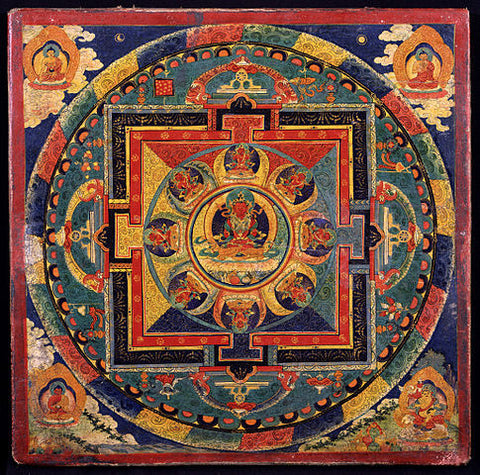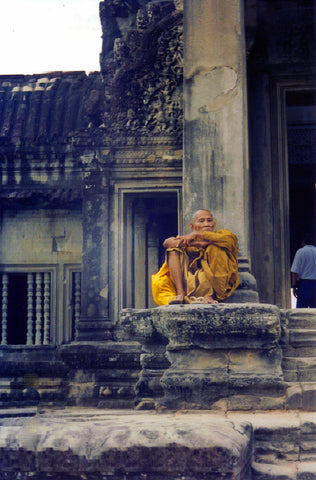Your Cart is Empty
Free Shipping for orders over $49 in Australia, $199 IN NEW ZEALAND/USA/CANADA AND $249 REST OF THE WORLD
Free Shipping for orders over $49 in Australia, $199 IN NEW ZEALAND/USA/CANADA AND $249 REST OF THE WORLD
Add description, images, menus and links to your mega menu
A column with no settings can be used as a spacer
Link to your collections, sales and even external links
Add up to five columns
Add description, images, menus and links to your mega menu
A column with no settings can be used as a spacer
Link to your collections, sales and even external links
Add up to five columns
The Spirituality and Symbology of the Mandala
by Linda Heaphy June 14, 2017

Mandala of Amitayus, artist unknown (19th century Tibetan school). Paint on wood. Currently held in the Rubin Museum of Art. A classic mandala featuring circles, squares, gates, centre point and images of the Buddha. Photo credit: wikimedia commons
The mandala may be described as a concentric diagram representing the universe, and as holding both spiritual and ritual significance. Important especially to Buddhists and Hindus (although different kinds of mandalas may be found in every faith, including Native American teachings, Judaism and Christianity), the word is a Sanskrit one meaning having essence, containingor circle.
The basic physical form of most mandalas is a square containing or being contained by a circle with four gates or openings at the cardinal points. However mandalas can be far more complex depending on their intended meaning, incorporating concentric rings, geometric shapes and Mandelbrot-type repetitions. They may be painted on any material including paper, wood, stone or cloth, be fashioned from precious metals and worn as jewellery, or painted as murals on walls. Mandalas can also be created from transient materials such as butter, pigment dust and sand. In some south eastern cultures they are considered so important that entire temples and even building complexes may be modeled on the shape of the mandala.
Historically, the concept of the mandala as a circle of significance goes back to the earliest origins of human civilisation. In the Rigveda (1500 and 1200 BCE), one of humankind’s oldest surviving texts, the word mandala signifies a chapter or a collection of verses chanted in religious ceremonies. As Nitin Kumar states:
The universe was believed to originate from these hymns, whose sacred sounds contained the genetic patterns of beings and things, so there is already a clear sense of mandala as world-model.
Mandalas first start to be seen as visual representations in ancient Tibetan writing and sketches during 8th-9th CE and in paintings and on the walls of religious sanctuaries in the 11th – 12th CE. The use of the mandala has permeated every southeast Asian culture since then.

The very beautiful Taima Mandala. Japan, Kamakura period (1185-1336), 14th century
Hanging scroll, ink, colours, and gold on silk. Currently in the Honolulu Museum of Art.
The creation and contemplation of mandalas can serve several purposes. They may be used to focus attention, as a spiritual teaching tool, to establish a sacred space or as an aid to meditation or trance induction. When made out of transient materials they become an offering, created to assist in the attainment of enlightenment, the seeking of liberation from samsara (cycle of birth and rebirth), or the development of attributes such as compassion and wisdom.
Every detail of a mandala is fixed in cultural tradition and has specific symbolic meanings, often on several complex physical and spiritual levels. Circles represent different levels of the cosmos, while squares represent earthly planes. The centre represents the self, devotion and contemplation of the divine. Other geometric shapes such as triangles and crosses may refer to specific deities or concepts, while important attributes such as purity, positive energy or wisdom are referenced by objects such as the lotus, wheel of fire, labyrinth, thunderbolt sceptres (vajras) and graveyards. Colour also plays an important role in nuanced meanings of the mandala. The entire universe, every metaphysical concept of self and the relationship between all living beings can be represented within the confines of a single mandala, no mean feat for this deceptively simple device.

A simple mandala. Or is it? The Chinese K'o-ssu depicting Mount Meru. Yuan dynasty (1271–1368). Silk tapestry. This elaborate tapestry-woven mandala illustrates Indian imagery introduced into China in conjunction with the advent of Esoteric Buddhism. At the center is the mythological Mount Meru, represented as an inverted pyramid topped by a lotus, a Buddhist symbol of purity. Traditional Chinese symbols for the sun (three-legged bird) and moon (rabbit) appear at the mountain’s base. The landscape vignettes at the cardinal directions represent the four continents of Indian mythology but follow the conventions of Chinese-style “blue-and-green” landscapes. The dense floral border derives from imagery of central Tibet, particularly from monasteries with ties to the court of the Yuan dynasty. Photo credit: Wikimedia commons
References and Further Reading
Kumar, N 2000.Mandala – Sacred Geometry in Buddhist Art. Exotic India
Mandala.Wikipedia. Accessed 15th June 2017.
Mandala Symbols.Mandalas for the Soul.Accessed 15th June 2017
Thorp, CL 2017. Tibetan Sand Mandalas. Ancient History Encyclopaedia
Leave a comment
Comments will be approved before showing up.
Also in Symbols & Ritual Objects

Om Mani Padme Hum – the Mantra of Compassion
by Linda Heaphy July 03, 2017
Beliefs And Customs Buddhism Eight Auspicious Symbols Nepal Om Prayer wheel Religion Spirituality Symbology Tibet
Read More Articles
About the Author
- Linda has a Honours degree in Marine Biology and a PhD in Ecology from the University of NSW, Australia. She has travelled extensively and is a passionate writer on subjects as diverse as the role played by women throughout history, tribal communities and their customs, symbology and ethnology, talismans and their history. Occasionally she also writes about her travel experiences, her new life on a 25 acres in the Northern Rivers region of northern Australia and her black miniature poodle Phoenix. She is currently writing her first book on talismans.
About Us
-
The Kashgar Philosophy

Kashgar began through a love of travel.
In 1989 my father Bernard packed in his house painting business and set off for two years on a backpacking trek to the remotest corners of the world. When he finally arrived in the oasis city of Kashgar, China, he was so impressed with its history that he decided to start a new life collecting and selling exotic goods from all over the world. For 2000 years the legendary city of Kashgar was a melting pot of ideas and a key trading post on the historic Silk Road. It was this unique combination of philosophy and trade that my father wanted to recreate at home.
Starting in markets in 1991, he opened his first store in the Sydney suburb of Newtown in 1994. I gave up my own career as a government scientist to join him in 2000 and soon convinced my partner Ian to join us in what was to become the Family Business.
Today our version of Kashgar stocks a hugely diverse range of furniture, rugs, textiles, antiques, handicrafts and jewellery sourced from over twenty different countries including India, Nepal, Tibet, China, Thailand, Burma, Laos, the Philippines, Vietnam, Mexico, Peru, Turkey, Palestine, Syria, Afghanistan and Turkmenistan. Our collection includes contemporary and tribal silver and gold jewellery, a unique range of headhunting curios, antique Buddhist relics and a collection of one-off necklaces, earrings and bracelets that I design and create myself using the beads and jewellery making techniques of ethnic minorities from around the globe.
Kashgar is a philosophy as well as a store. We are committed to supporting traditional artisans and small village communities by selling authentic handcrafted goods which are personally collected by us. By supporting traditional methods of design and production we hope to encourage local cottage industries which have a low impact on the environment and help ethnic minorities maintain their self-sufficiency into the 21st Century. We are particularly committed to assisting women around the world and to this end have worked with several organisations including the Hua Bin Women's Union of Vietnam, the East Timorese Women's Association and Tikondane in Zambia. Time honoured means of craftsmanship and traditional ways of life are disappearing as people all over the world give up their identity in favour of jeans and T-shirts. We see our trade as a means of staving off the inevitable encroachment of the 21st century, assisting communities to decide for themselves which parts of the western world they wish to incorporate (medicine, education) and which they wish to reject (prostitution, drug production, begging and servitude to warlords). We encourage our customers to think of the handicrafts and artifacts they buy from us as an investment: a piece of history and a way of life that may soon be gone forever.
Kashgar has recently closed its retail outlet and gone completely online.
In the past our pieces appeared in many movies including The Hobbit, Mission Impossible 2, Queen of the Damned, Scooby Doo, Moulin Rouge and Wolverine, and in many televisions series, as well as in plays, commercials and exhibitions. We've found special pieces for individual customers as well as for film sets, event management companies, hotels, businesses, consulates and embassies. The uniqueness of our stock means that we are also very appealing to interior and fashion designers with a taste for the exotic.
There is something for everyone at Kashgar - collectors, the curious, those looking for a special present or for something unique to adorn the home. Most of our items are one-off specialties; other pieces we only stock in small quantities so as to continuously offer a wide and ever-changing range of interesting products. We are also packed with ideas for decorating home and work premises that will challenge your established concepts of design and storage.

Please enjoy - Linda Heaphy
Become a Kashgar nomad and join our mailing list...
Sign up to get the latest on sales, new releases and more …




